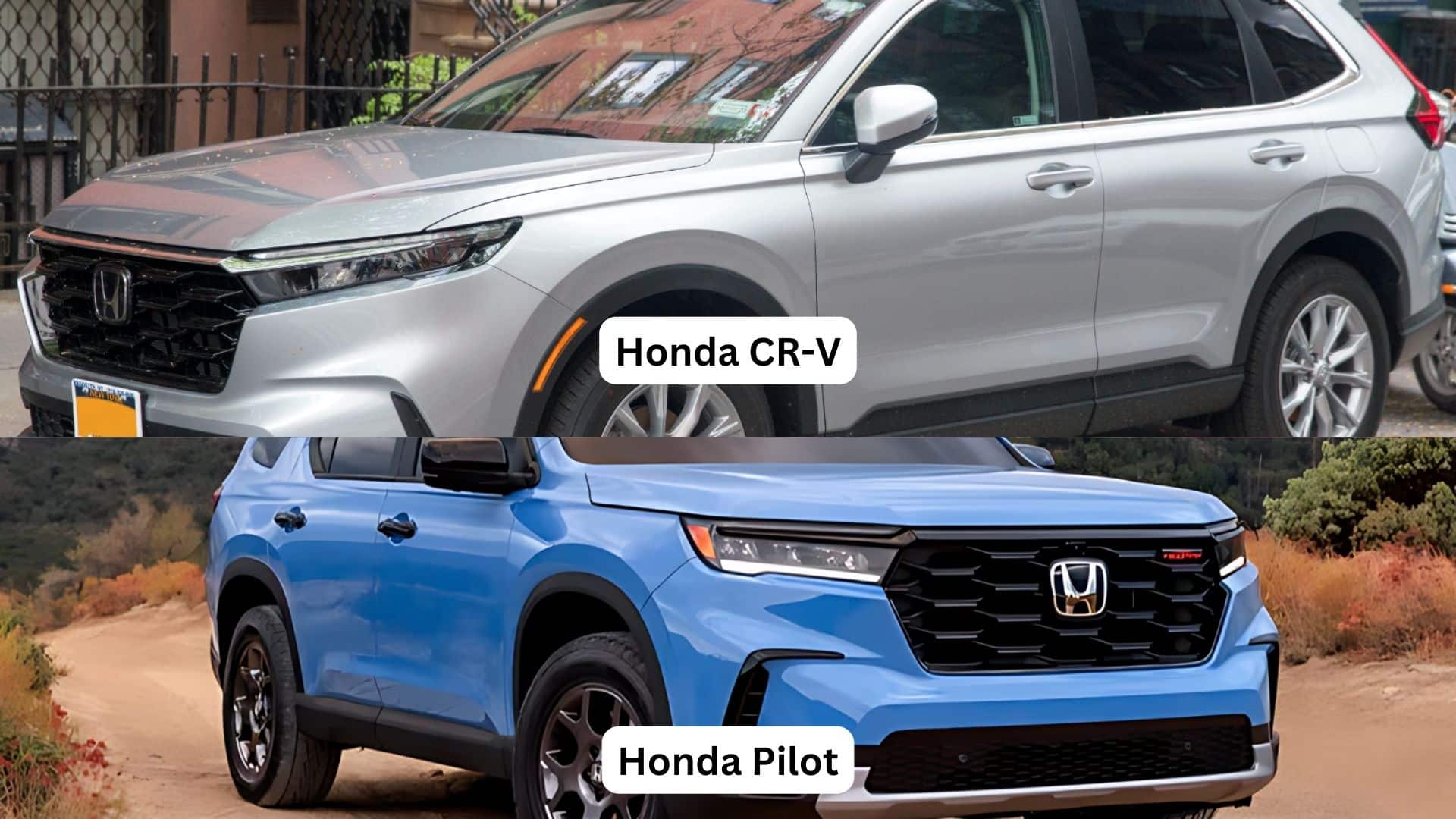Honda’s CR-V and Pilot are popular choices for families seeking reliable SUVs. Many drivers wonder about the fuel efficiency of these two models.
You’re not alone if you’re torn between the CR-V and the Pilot. Fuel economy plays a big role in long-term costs and environmental impact.
We’ll compare the CR-V and Pilot to help you make an informed decision. This guide breaks down their fuel efficiency, highlighting key factors that affect gas mileage.
We’ll explore engine specs, vehicle size, and design elements that impact how far each SUV can go on a tank.
By the end, you’ll see which Honda SUV offers better fuel economy for your needs.
Engine Specifications

Let’s take a look at what’s powering the CR-V and Pilot. The engines in these two Honda SUVs are key to how they use fuel.
Their different sizes and designs affect both power output and gas consumption. Understanding these engines will help explain the differences in fuel use, which we’ll see later.
Let’s compare the CR-V and Pilot engines to set the stage for our fuel efficiency discussion.
1. Honda CR-V Engine
The CR-V comes with a 1.5-liter turbocharged four-cylinder engine. This compact powerplant generates 190 horsepower and 179 lb-ft of torque.
The smaller engine size helps the CR-V achieve better fuel economy.
2. Honda Pilot Engine
In contrast, the Pilot boasts a larger 3.5-liter V6 engine. This more powerful motor produces 280 horsepower and 262 lb-ft of torque.
The Pilot’s engine offers more muscle for towing and hauling but uses more fuel.
3. Engine Impact on Performance
These engine differences are key to how each SUV performs on the road and at the pump.
The CR-V’s smaller engine focuses on efficiency, while the Pilot’s larger V6 delivers more power at the cost of higher fuel use.
Fuel Consumption Comparison

The Honda CR-V and Pilot show clear differences in fuel use. The CR-V leads to efficiency, using less gas in various driving conditions.
City and Highway MPG
The CR-V uses fuel wisely in city driving, getting 28 miles per gallon. On highways, it does even better, reaching 34 miles per gallon.
When you mix city and highway driving, the CR-V averages 30 miles per gallon.
The Pilot, being larger, uses more fuel. In cities, it gets 19 miles per gallon. On highways, it improves to 27 miles per gallon. For mixed driving, the Pilot averages 22 miles per gallon.
Hybrid Option for CR-V
For those wanting top efficiency, the CR-V offers a hybrid option. This version can reach up to 40 miles per gallon in cities and 35 on highways.
These numbers show the CR-V as the clear winner for fuel saving. Drivers who want to spend less on gas and make fewer stops at fuel stations might prefer the CR-V, especially its hybrid version.
Performance and Efficiency

The CR-V and Pilot offer different driving experiences due to their unique designs.
Transmission and Driving Range
The CR-V uses a Continuously Variable Transmission (CVT), which helps it save fuel.
This system allows the CR-V to travel up to 392 miles in the city or 476 miles on the highway before needing more gas.
The Pilot comes with a 10-speed automatic transmission. It can go 352 miles in the city or 500 miles on the highway on a full tank. The Pilot’s slightly longer highway range shows its strength on long trips.
Weight and Maneuverability
Weight plays a big role in how these SUVs handle. The CR-V is lighter, making moving around in tight spaces easier. It’s a good fit for city driving and parking.
The Pilot weighs more, making it feel more stable on highways. Its design also helps it handle unpaved roads better than the CR-V.
Each SUV’s performance and efficiency match different driving needs. The CR-V shines in everyday city use, while the Pilot excels on long trips and rougher terrain.
Fuel-Saving Features

The Honda CR-V and Pilot have tools to help drivers use less fuel. These features work behind the scenes to stretch each gallon of gas further.
CR-V’s Efficiency Tools
The CR-V has an Eco Assist System, which helps the engine use fuel efficiently.
It also has an Idle-Stop feature, which turns off the engine when the car isn’t moving. This stops the vehicle from using gas when it’s unnecessary, like at red lights.
The CR-V offers a hybrid option for those who want to save more on fuel. This version combines a gas engine with electric power to use much less fuel.
Pilot’s Fuel Economy Systems
The Pilot also tries to save fuel but in different ways. It has Variable Cylinder Management (VCM), which turns off some engine parts when the car doesn’t need full power.
The Pilot also uses an Eco Assist System, like the CR-V, to help drivers get the most miles from each gallon.
These features show how both SUVs try to use less fuel. The CR-V, especially its hybrid version, offers more gas-saving ways.
The Pilot’s systems work well for its larger size but can’t match the CR-V’s efficiency.
Cost Analysis

When choosing between the CR-V and the Pilot, it’s important to consider both the upfront price and long-term costs.
Initial Purchase Price
The CR-V’s lower starting price makes it more budget-friendly at first. The Pilot costs more but offers more power and can carry more people.
Long-Term Fuel Expenses
Over time, the costs of owning these SUVs can change. The big difference comes from how much gas they use.
The CR-V uses less fuel, which means you’ll spend less money at gas stations. This saving adds up over the years. If you drive a lot, you might save a lot of money with the CR-V.
The Pilot uses more gas, so you’ll spend more on fuel over time. This higher fuel cost can make the Pilot more expensive to own in the long run, even if you need extra space and power.
When deciding, consider your budget and how much gas you’ll spend later. The CR-V costs less to run, while the Pilot offers more space and power at a higher price.
Environmental Impact

Considering cars and the environment, how much fuel they use is a big deal. The CR-V and Pilot have different effects on our planet.
CR-V’s Eco-Friendly Profile
The CR-V is kinder to the environment. It uses less fuel, which means it puts out fewer harmful gases. When you drive a CR-V, you’re not adding as much to air pollution. This is good news for our cities and towns.
If you choose the CR-V hybrid, you do even more to help. Hybrid cars use less gas and produce fewer harmful gases, making them a top pick for eco-friendly drivers.
Pilot’s Environmental Footprint
The Pilot’s bigger engine uses more fuel, which releases more gases into the air that can harm our planet. It’s not as green as the CR-V.
The CR-V, especially the hybrid, is the better choice for drivers who care about the earth. It lets you drive while doing less harm to our environment. The Pilot, while roomy and powerful, leaves a bigger mark on our planet.
Conclusion
In comparing the CR-V and Pilot, we’ve seen how these Honda SUVs differ in fuel use and environmental impact.
The CR-V stands out for its efficiency. It offers better gas mileage and a hybrid option that further reduces fuel costs and emissions.
While less fuel-efficient, the Pilot provides more power and space for larger families or those needing extra capacity.
Your choice between the CR-V and Pilot will depend on your priorities. The CR-V is the winner if you value fuel savings and a smaller environmental footprint.
However, the Pilot might be your best bet if you need more room and power and can manage higher fuel costs.
Remember, the right SUV balances your daily needs with long-term costs and environmental concerns. Consider test driving both to see which best fits your lifestyle.
Frequently Asked Questions
1. What is the gas mileage on a CR-V vs Pilot?
The CR-V gets better gas mileage than the Pilot. The CR-V averages 28 mpg in the city and 34 mpg on highways.
The Pilot averages 19 mpg in the city and 27 mpg on highways. The CR-V hybrid offers even better efficiency, reaching up to 40 mpg in city driving.
2. How much longer is a Honda Pilot than a Honda CR-V?
The Honda Pilot is about 15 inches longer than the CR-V. The CR-V measures around 182 inches, while the Pilot is about 197 inches long.
This extra length gives the Pilot more interior space and a third row of seats, but it makes it less maneuverable in tight spaces.
3. Is the Honda CR-V fuel-efficient?
Yes, the Honda CR-V is fuel-efficient. It offers good gas mileage for its class, especially in its hybrid form.
The standard CR-V gets up to 34 mpg on highways, while the hybrid version can reach 40 mpg in city driving. These numbers make it a smart choice for those looking to save on fuel costs.
4. Which Honda is best in fuel consumption?
Among Honda’s SUV lineup, the CR-V hybrid is the best in terms of fuel consumption. It offers up to 40 mpg in city driving and 35 mpg on highways.
The standard CR-V leads with its combined 30 mpg rating for non-hybrid models. Honda’s smaller cars, like the Civic, can offer even better fuel economy.


